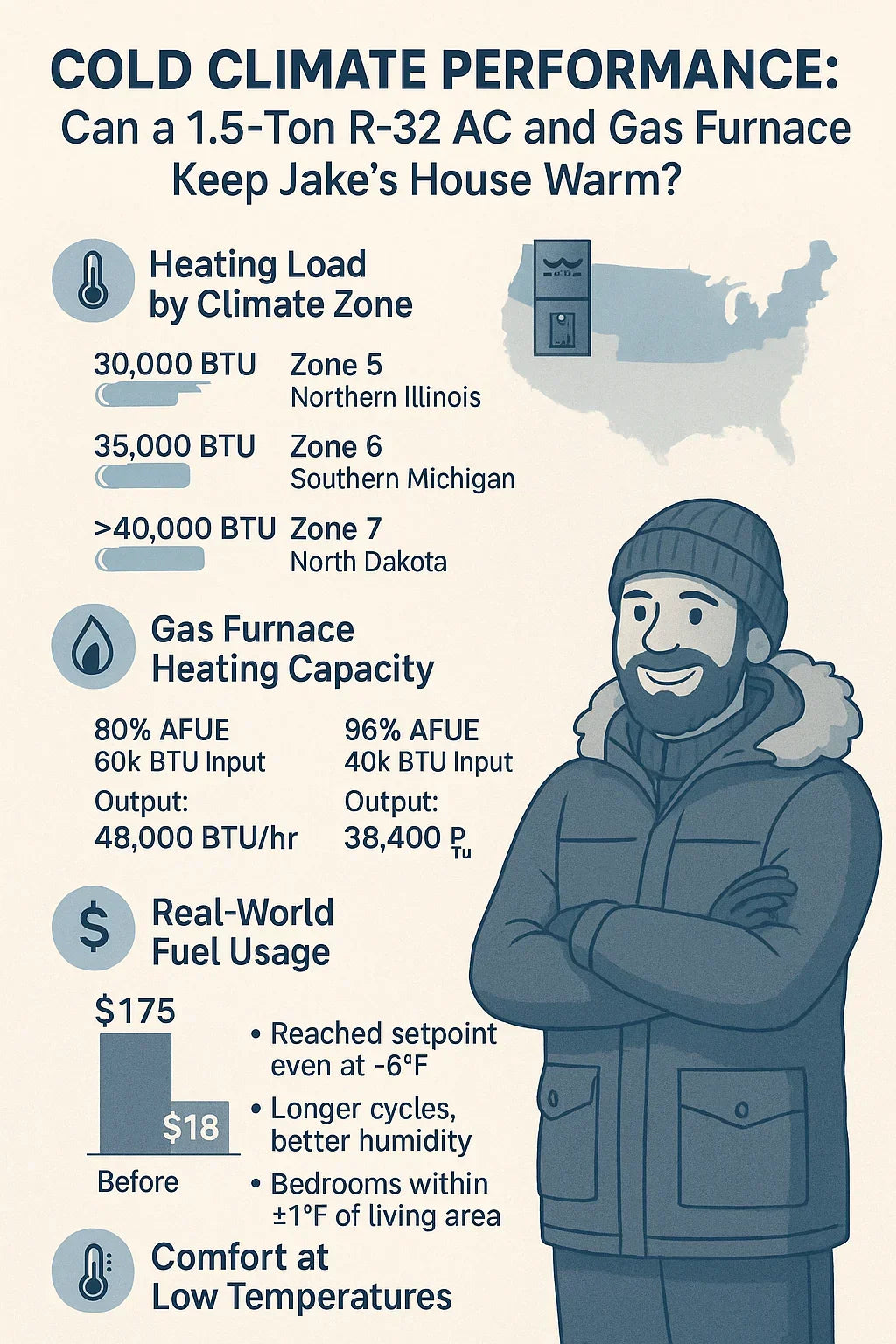🏠 Jake’s Winter Worry
When I upgraded to a 1.5-ton R-32 AC and a 40k BTU high-efficiency gas furnace, I wasn’t worried about summer. Cooling my 900 sq. ft. home in the Midwest was going to be a breeze.
Best 1.5 Ton AC and Gas Furnaces
Winter? That was another story.
We’re talking January lows below zero and a few blizzards that make your nose freeze in seconds.
My question was simple:
Can a “small” system actually keep me warm without running 24/7?
I decided to put it to the test, from first snow to the last stubborn frost.
🌡 Understanding Heating Load in Cold Climates
📏 Manual J Load Basics
Heating load is the amount of heat your furnace needs to produce to keep your house at your desired indoor temperature — usually 68–72°F — when it’s cold outside.
Manual J is the standard calculation HVAC pros use. It factors in:
-
Square footage
-
Insulation quality (walls, attic, floor)
-
Window type and quantity
-
Air leakage (tight vs. drafty home)
-
Climate zone
Jake’s Home Numbers
-
Location: Climate Zone 5 (Northern Illinois)
-
Home size: 900 sq. ft., one story
-
Insulation: R-38 attic, R-15 walls
-
Windows: Double-pane vinyl
-
Air leakage: Fairly tight after weatherstripping
Manual J result: ~24,000–28,000 BTU/hr heating load on the coldest design day (-4°F outside).
🔥 Gas Furnace BTU Output
📈 Input vs. Output
-
Input BTU: How much fuel energy goes into the furnace
-
Output BTU: How much usable heat comes out after losses
Example:
My furnace is rated 40,000 BTU input with 96% AFUE.
Output = 40,000 × 0.96 ≈ 38,400 BTU/hr
That’s comfortably above my 28,000 BTU load — leaving ~10,000 BTU/hr reserve for recovery after setback.
Why Small Can Beat Old Big
An old 80% AFUE 60k BTU furnace puts out 48,000 BTU/hr — but wastes more fuel.
My smaller, efficient furnace runs longer cycles, which:
-
Evens out temperatures
-
Reduces cold spots
-
Improves humidity balance
💨 Airflow & Comfort in Winter
🌬 Supply Air Temperature
My furnace pushes out 110–125°F air in low stage and 130–140°F in high stage.
Lower stage is more comfortable — no “blast furnace” effect, and the room warms evenly.
📏 Duct Design Impact
Even with the right BTUs, bad ductwork kills comfort. My installer:
-
Sealed all joints with mastic
-
Balanced supply registers
-
Increased return size to reduce noise
❄ How R-32 AC Fits Into Winter Performance
AC in Winter Mode
When paired with a gas furnace, the AC coil just sits in the plenum during winter.
R-32 has no direct impact on heating unless you’re using a heat pump.
However:
-
The coil does add a small airflow resistance
-
A clean coil is important for winter efficiency
Cold Climate & Refrigerant Concerns
For A2L refrigerants like R-32, indoor installation safety rules matter year-round — even if the refrigerant is mostly idle in winter.
📉 Real-World Fuel Usage & Bills
Before Upgrade
-
Furnace: 80% AFUE, 60k BTU input
-
January gas bill: ~$175 (thermostat at 69°F)
After Upgrade
-
Furnace: 96% AFUE, 40k BTU input
-
January gas bill: ~$138 (same thermostat setting)
That’s ~21% less gas used — even in a month with similar heating degree days.
Runtime Behavior
At 20°F outside:
-
Low stage ~70% of time, high stage for morning recovery
At -5°F: -
High stage 100% during morning warm-up, then cycles between stages
🔄 Comparing to Cold-Climate Heat Pumps
Heat Pump Pros
-
Can use R-32 refrigerant for efficient heating down to ~5°F
-
Lower operating cost in areas with cheap electricity
-
No on-site combustion
Heat Pump Cons in Jake’s Climate
-
Needs backup heat below ~5°F
-
Slower temperature recovery after setbacks
-
Larger upfront cost for cold-climate models
📎 Cold Climate Heat Pump Performance
🛠 Cold Climate Upgrade Tips
1. Insulation & Air Sealing
Every BTU you don’t lose is a BTU you don’t have to pay for.
-
Add attic insulation to R-49 or better
-
Seal top plates, rim joists, and around windows/doors
2. Humidification
Cold air is dry. I run a bypass humidifier to keep indoor RH ~35%, which makes 69°F feel warmer.
3. Blower Delay Settings
Letting the blower run 60–90 seconds after the burners shut off pulls extra heat out of the exchanger.
4. Smart Thermostat
Adaptive recovery avoids sudden high-stage surges.
📎 ENERGY STAR — Smart Thermostat Tips
✅ Jake’s Verdict After One Winter
Comfort
-
Never dropped below setpoint, even at -6°F
-
Bedrooms stayed within ±1°F of living room
-
Longer cycles meant no “cold feet” feeling
Efficiency
-
Cut gas use by ~20% compared to old furnace
-
Electric use barely changed — blower is ECM motor
Recommendation
A 1.5-ton AC with a 40k–60k BTU high-efficiency gas furnace can absolutely keep a small to medium, well-insulated home warm in Zone 5–6 climates.
If your Manual J load is close to or under 38,000 BTU/hr output, you’re golden.
If it’s much higher, consider upsizing to a 60k input model or adding zone heating.
In the next topic we will know more about: Troubleshooting a 1.5-Ton R-32 AC/Gas Furnace: Jake’s DIY Quick Fixes







